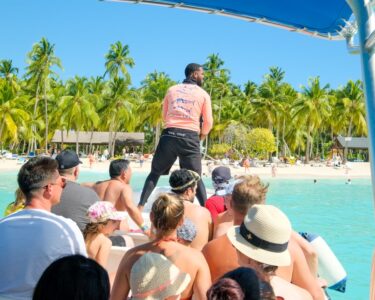The Jewel of the Dominican Republic
Introducing
Punta Cana, located on the easternmost tip of the Dominican Republic, has become one of the most visited tourist destinations in the Caribbean. Known for its white sandy beaches, turquoise waters, and luxurious resorts, the city attracts millions of visitors each year. With a blend of adventure, relaxation, and culture, Punta Cana offers a unique travel experience that suits a wide range of vacation styles.
1. A Brief History of Punta Cana
1.1 Pre-Colonial Times and Indigenous People
Before Punta Cana became a tourist hub, it was home to the Taino people. This indigenous group occupied the Dominican Republic long before Christopher Columbus arrived in 1492. The Taino culture, language, and traditions left a lasting imprint on the island’s heritage.
1.2 Colonial Era

After the arrival of Spanish colonizers, Punta Cana—like much of the Caribbean—underwent significant transformation. Plantations were established, and European settlers brought new customs, religion, and architecture. The island’s colonial history, particularly the importance of Santo Domingo, the capital, shaped much of the region’s development.
1.3 Modern Development and the Birth of Tourism
Punta Cana remained a largely undeveloped region until the late 1960s when investors recognized its potential as a tourist destination. Developers built the first resort in the early 1970s, which marked the beginning of Punta Cana’s transformation into a world-class vacation spot. With the construction of Punta Cana International Airport in 1984, accessibility to the region improved dramatically, further boosting tourism.
2. Why Punta Cana is the Most Visited City?

2.1 Beaches and Natural Beauty
The main reason travelers flock to Punta Cana is its incredible beaches. With over 30 miles of coastline along the Atlantic Ocean and the Caribbean Sea, it offers a tropical paradise that’s hard to resist. Beaches such as Bávaro Beach and Macao Beach are known for their powdery white sand and crystal-clear waters, providing ideal spots for sunbathing, swimming, and water sports.
2.2 All-Inclusive Resorts
Punta Cana is famous for its extensive range of all-inclusive resorts. These resorts cater to different types of travelers—whether it’s families, honeymooners, or solo adventurers. Many offer luxurious accommodations, gourmet dining, and entertainment options. The convenience and amenities of all-inclusive packages appeal to those looking for a stress-free vacation.
2.3 Adventure and Activities
Adventure seekers find plenty to do in Punta Cana. From water sports such as snorkeling, scuba diving, and parasailing, to eco-tourism activities like hiking and exploring the nearby Indigenous Eyes Ecological Park, the area offers diverse experiences for outdoor enthusiasts. Punta Cana is also home to some of the best golf courses in the Caribbean, designed by top architects like Jack Nicklaus.
2.4 Nightlife and Entertainment
The nightlife in Punta Cana is another significant draw. The city’s clubs, bars, and beachfront venues come alive after dark, offering everything from live music to DJ performances. Iconic venues like Coco Bongo provide an immersive party experience with entertainment shows that blend dance, music, and acrobatics.
2.5 Accessibility and Infrastructure
Punta Cana’s growth as a tourist destination can also be attributed to its accessibility. Punta Cana International Airport (PUJ) is the busiest airport in the Dominican Republic and one of the most connected in the Caribbean. With direct flights from major cities across North America, Europe, and Latin America, the airport makes traveling to Punta Cana easy and convenient.
3. The Culture
3.1 Cultural Festivals and Events
Although it’s primarily known as a resort town, Punta Cana celebrates a variety of cultural festivals and events that showcase the rich Dominican culture. Carnival is one of the most vibrant, where locals and tourists join in colorful parades, traditional music, and lively dance performances.
3.2 Music and Dance
The Dominican Republic is famous for merengue and bachata music, both of which can be experienced throughout Punta Cana. Many resorts and local clubs host live music events where visitors can learn to dance like the locals and enjoy the upbeat rhythms that define the Dominican culture.
3.3 Cuisine
Punta Cana offers a fusion of traditional Dominican flavors and international cuisine. Visitors can enjoy authentic dishes such as mofongo, sancocho, and tostones, while also indulging in gourmet meals at resort restaurants. The abundance of fresh seafood adds to the culinary appeal of the region.
4. Top Attractions and Day Trips
4.1 Saona Island
A visit to Saona Island is one of the most popular day trips from Punta Cana. Located in a national park, the island is known for its pristine beaches and shallow turquoise waters, making it perfect for snorkeling and swimming. Catamaran tours to Saona Island offer a fun-filled day with music, dancing, and tropical drinks on board.
4.2 Hoyo Azul
For nature lovers, the Hoyo Azul cenote is a must-see. This natural sinkhole features crystal-clear blue waters and is nestled at the base of a cliff. Visitors can take guided tours to swim in its refreshing waters while learning about the flora and fauna of the surrounding area.
4.3 Scape Park
Scape Park at Cap Cana is a popular eco-adventure park offering ziplining, cave exploration, and cenote swims. It’s a family-friendly attraction that showcases the natural beauty of Punta Cana’s tropical landscape. The park also includes cultural exhibits where visitors can learn more about the history of the region.
5. Punta Cana as a Family-Friendly Destination
5.1 Resorts with Family Amenities
Punta Cana is an excellent choice for families, thanks to its range of family-friendly resorts. Many offer kid’s clubs, water parks, and supervised activities for children, allowing parents to relax while their kids are entertained. Resorts such as Nickelodeon Hotels & Resorts Punta Cana cater specifically to families with themed rooms and character meet-and-greets.
5.2 Educational Tours for Kids
In addition to beach activities, Punta Cana offers educational experiences for children. The Indigenous Eyes Ecological Park allows families to explore nature trails and learn about local wildlife. Many tours include interactive experiences that teach kids about the environment and conservation efforts in the region.
6. Sustainability and Eco-Tourism
6.1 Sustainable Tourism Practices
With the growth of tourism comes a greater focus on sustainability. Punta Cana has made strides in promoting eco-friendly practices to protect its natural resources. Many resorts have adopted green initiatives, such as reducing plastic waste, conserving water, and supporting local environmental efforts. These measures are vital for maintaining the beauty of the region for future generations.
6.2 Community-Based Tourism
Another trend in Punta Cana is the rise of community-based tourism. This involves engaging with local communities and contributing to their development through sustainable practices. Tourists can visit local villages, purchase handmade crafts, and participate in cultural exchanges, supporting the local economy while gaining a deeper understanding of Dominican culture.
7. The Future of Tourism in Punta Cana
7.1 Post-Pandemic Tourism
The COVID-19 pandemic had a significant impact on tourism worldwide, and Punta Cana was no exception. However, the city has bounced back as travel restrictions have eased. With the implementation of strict health and safety protocols, the city has become a safe destination for post-pandemic travel, attracting a steady flow of visitors once again.
7.2 Emerging Trends
Looking forward, the. city is expected to continue growing as a tourist destination. New resorts and infrastructure projects are in the works, further enhancing the city’s appeal. Additionally, the rise of wellness tourism, which focuses on health and relaxation, is likely to attract more visitors seeking rejuvenation in a tropical setting.



